七下 期末复习课件Unit 1-Unit 6 考点复习课件(共54张PPT)
文档属性
| 名称 | 七下 期末复习课件Unit 1-Unit 6 考点复习课件(共54张PPT) |  | |
| 格式 | pptx | ||
| 文件大小 | 2.4MB | ||
| 资源类型 | 教案 | ||
| 版本资源 | 人教新目标(Go for it)版 | ||
| 科目 | 英语 | ||
| 更新时间 | 2024-06-25 13:23:02 | ||
图片预览

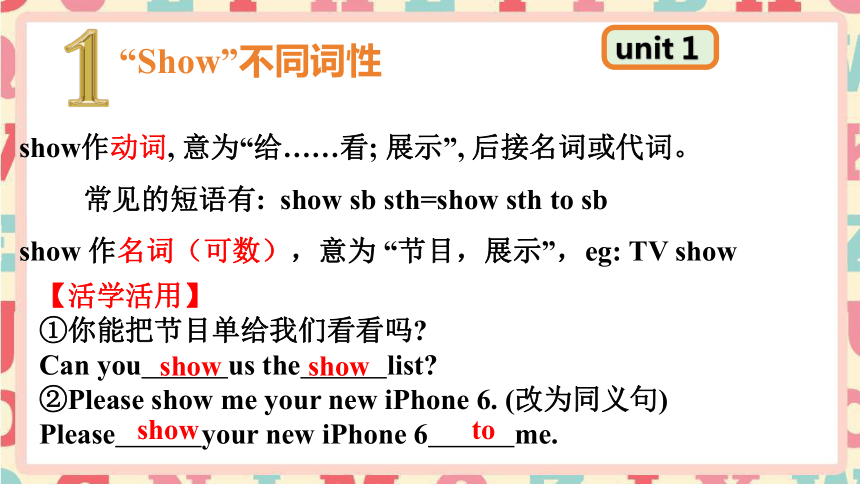
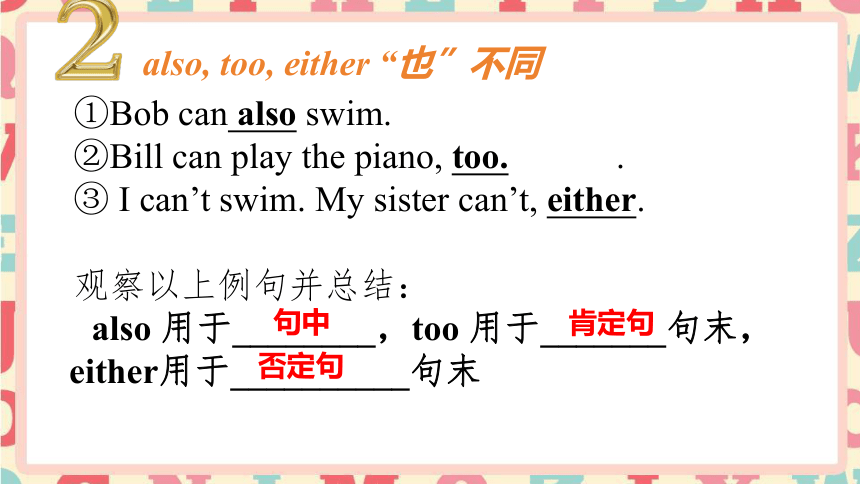
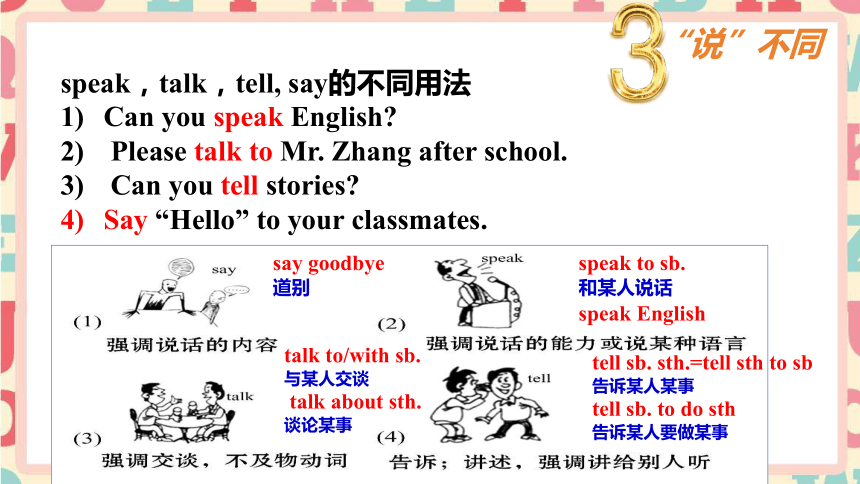


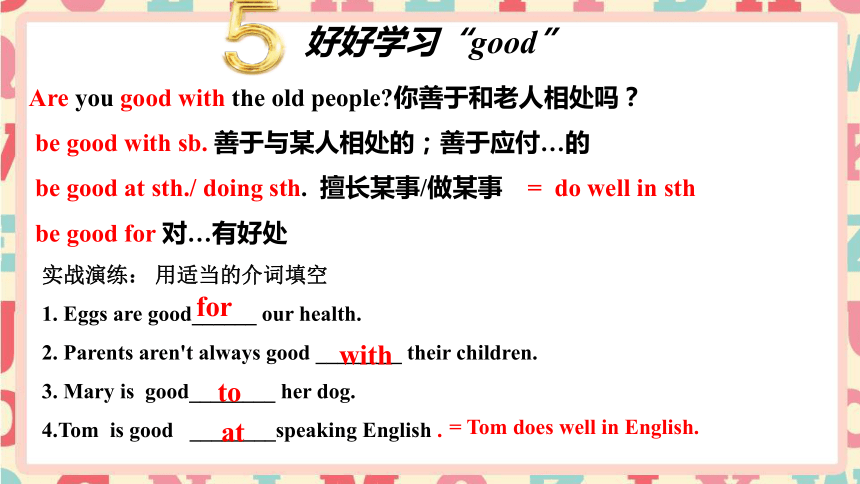

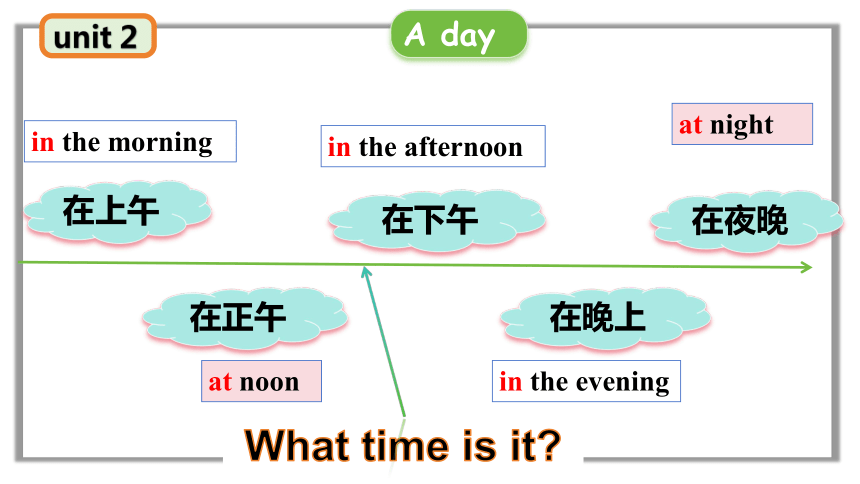
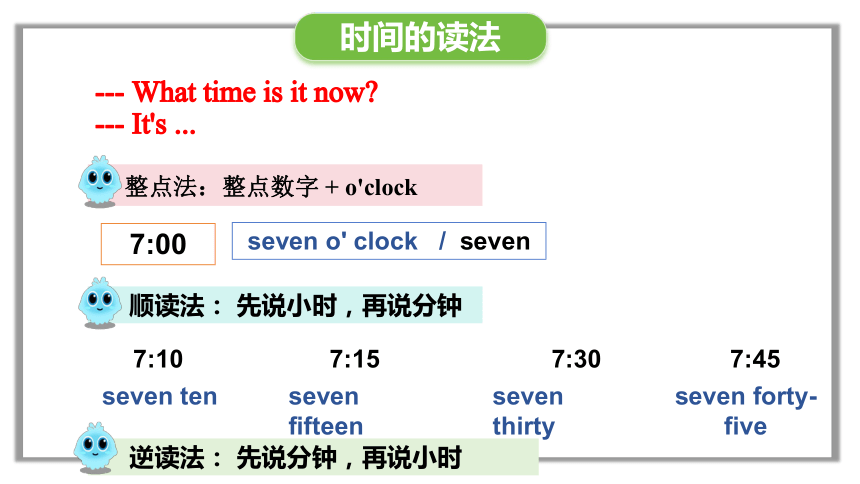

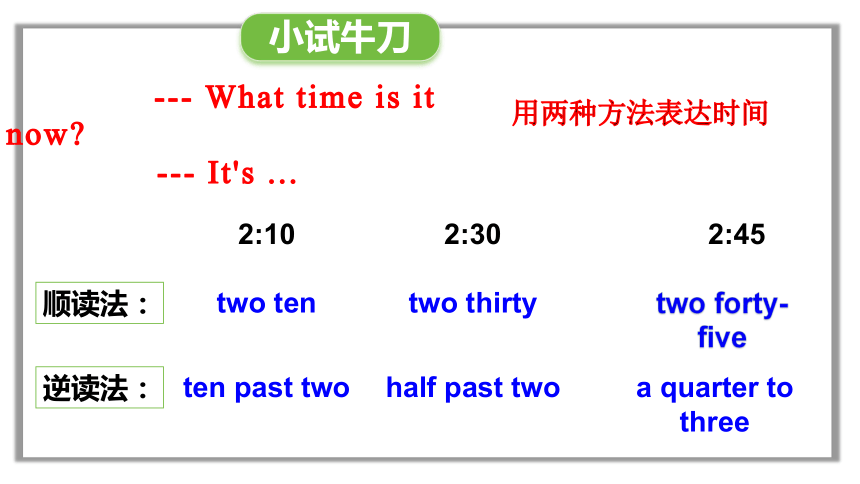
文档简介
(共54张PPT)
人教版七年级下册复习课件
unit 1-unit 6 考点复习
“Show”不同词性
show作动词, 意为“给……看; 展示”, 后接名词或代词。
常见的短语有: show sb sth=show sth to sb
show 作名词(可数),意为 “节目,展示”,eg: TV show
【活学活用】
①你能把节目单给我们看看吗
Can you us the list
②Please show me your new iPhone 6. (改为同义句)
Please your new iPhone 6 me.
show show
show to
unit 1
also, too, either “也”不同
句中
肯定句
否定句
①Bob can also swim.
②Bill can play the piano, too. .
③ I can’t swim. My sister can’t, either.
观察以上例句并总结:
also 用于________,too 用于_______句末, either用于__________句末
speak,talk,tell, say的不同用法
Can you speak English
Please talk to Mr. Zhang after school.
Can you tell stories
Say “Hello” to your classmates.
“说”不同
speak to sb.
和某人说话
talk to/with sb.
与某人交谈
talk about sth.
谈论某事
tell sb. sth.=tell sth to sb
告诉某人某事
tell sb. to do sth
告诉某人要做某事
say goodbye
道别
speak English
用say, speak, talk与tell填空。
①We all Putonghua in our school.
②Bill often us very interesting stories.
③Don’t forget to “Thank you ”when someone helps you.
④Lucy likes to meet and to different people.
speak
tells
say
talk
…we need you to help with sports …
help (sb.) with sth 在某方面帮助(某人)
help sb. (to) do sth. 帮助某人做某事
Li Huan often _______ her mother _____________the housework.
Can you help me _________ (clean) the floor
helps
with/ do
请你帮帮我 (help 的用法)
(to) clean
Are you good with the old people 你善于和老人相处吗?
be good with sb. 善于与某人相处的;善于应付…的
be good at sth./ doing sth. 擅长某事/做某事 = do well in sth
be good for 对…有好处
好好学习“good”
实战演练: 用适当的介词填空
1. Eggs are good______ our health.
2. Parents aren't always good ________ their children.
3. Mary is good________ her dog.
4.Tom is good ________speaking English .
with
to
at
for
= Tom does well in English.
join, join in 与 take part in
join
join in
take part in
指加入某党派、组织或社会团体。
指加入某种活动,多指参加小规模的活动,如球赛、游戏等,常用于日常口语。
指参与群众性活动、会议等,往往指参加者持积极态度,能起一定作用。
eg: I want to ______ the English club. 我想要参加英语社团。
She usually __________ the football game. 她经常参加足球比赛。
They need to________________a sports meeting tomorrow.
他们明天需要参加一个运动会。
join
joins in
take part in
A day
在上午
在正午
在下午
在晚上
在夜晚
in the morning
at noon
in the afternoon
in the evening
at night
What time is it
unit 2
时间的读法
逆读法: 先说分钟,再说小时
顺读法: 先说小时,再说分钟
整点法:整点数字 + o'clock
7:00
--- What time is it now
--- It's ...
seven o' clock / seven
7:10
seven ten
7:15
seven fifteen
7:30
seven thirty
7:45
seven forty-five
逆读法: 先说分钟,再说小时
> 30 minutes
(60-分钟) +to+ (小时+1)
差...到...点
≤ 30 minutes
分钟 +past + 小时
...点过了...分
7:10
ten past seven
7:15
7:30
7:45
fifteen past seven
thirty past seven
fifteen to eight
a quarter
half
a quarter
--- What time is it now
--- It's ...
用两种方法表达时间
小试牛刀
2:30
2:45
two thirty
two forty-five
a quarter to three
顺读法:
逆读法:
half past two
2:10
two ten
ten past two
词语 含义 询问对象 回答
what time 用介词
__
when 用介词
__
几点
什么时候
笼统的时间或具体的时间点
at
具体时间点
in, on, at
when & what time
on,at,in
on用在日期、星期几、节日前,
也表示在具体某一天的上午、下午和晚上。
on November 1st; on Monday; on Children's Day;
on Tuesday evening; on the morning of April 3rd
at用于具体的时刻。如: at 9:00; at 6:30
in用于月份、季节、年份前;
泛指一般的上、下午,晚上也用in
in March; in 2020; in summer;
in the morning/afternoon/evening
Her mother gets up ____ five-thirty every morning.
2. People usually eat breakfast ____ the morning.
3. They will go swimming ____ four ____ the afternoon.
4. I play soccer ____ Sunday afternoon.
5. Her birthday party is _____ March 8th.
at
in
at
in
on
on
请用at, in 或 on 填空。
小试牛刀
总是
通常
经常
有时
很少
从不
频率副词
1. I _____ take a walk with my father after dinner. It is healthy.
A. seldom B. sometimes C. never D. usually
2.The lazy student ________ does his homework on time.
A. ever B. never C. sometimes D. always
3. —Miss Gao is very popular with her students.
—Yes, her classes are ____ lively and interesting.
A. ever B. never C. sometimes D. always
D
B
D
小试牛刀
be/助/情后
动词前
unit 3
由how引导的常见特殊疑问词组
1
用法
(1) “How do / does sb. get to ... ”意为“某人怎么到……?”,该句型用于询问某人到某地的出行方式。
你是怎么到公园的?我步行。
—How do you get to the park
—I walk to the park. / I get to the park on foot.
拓展
描述出行方式的常见搭配:
by+交通工具
by bike/bus/car/train/subway...
take/ride/drive a/the+交通工具
take a/the bus/train/plane
ride a/the/one's bike
drive a/the/one's car
借助于on或in
on foot , in a/the/one's car
on a bike
rides her bike
by bike
walks
on foot
(2)how far意为“离……有多远”,用来询问距离。
如:从你家到学校有多远?大约2千米。
—How far is it from your home to school —About 2 kilometers.
(3)how soon意为“多久;多快”,一般用“in+时间段”构成的时间状语来回答。
如:你什么时候去美国?半个月后。
—How soon will you go to America?
—In half a month.
(4)how often意为“多久一次;多经常”,用来询问频率。如:
—How often do you practice speaking English?
你多久练习一次英语口语?
—Every day.
每天(都练习)。
(5) how long意为“多久;多长时间”,
也可以用来询问物体的长度,意为“多长”。
eg:—How long is the Yellow River —About 6,400 kilometers.
黄河多长?约6 400千米。
—How long does it take you to get to work —About 15 minutes.
你去上班要用多长时间?大约15分钟。
按要求完成下列各题
1. It’s 3 kilometers from my home to my uncle’s home.(就画线部分提问)
________ ________ is it from your home to your uncle’s home
2. It takes about an hour to get to the library.(就画线部分提问)
_____ ______ does it take to get to the library
3. Her cousin often drives his car to work.(改为同义句)
Her cousin often goes to work ____ _____.
4. His best friend goes to the library by bike.(就画线部分提问)
_____ ______ his best friend ___ to the library
5. The boy usually gets to school on foot.(改为同义句)
The boy usually _______ ____ school.
far
How
How
long
by
car
How
does
walks
to
go
It takes about 20 minutes.
It takes sb. + some time+to do sth. 某事花费某人一些时间
注意:take是动词,所以sb. 是人称代词时,要使用宾格。
1.It takes me half an hour _______ my homework.
2.It takes ______ (he) ten minutes to get to school.
2
to do
him
( )3. It takes me an hour ________ the piano every day.
A. play B. playing C. to play D. to playing
C
afraid的用法
3
用法
afraid意为“害怕的;畏惧的”,是一个表语形容词。
afraid的常见搭配
拓展
那个男孩怕蛇。
不要害怕求助.
他晚上不敢独自出去。
恐怕你错了。
The boy _____________ snakes. Don’t ______________asking for help. He _____________ go out alone at night. I________________ you are wrong.
is afraid of
be afraid of
is afraid to
am afraid that
4
It is + 形容词+ to do sth. 做某事是怎么样的
It is + adj.+for sb. + to do sth. 做某事对某人来说是.....的.
此句型中的adj.若为描述事物特征的词,则用for
It is difficult _________to swim.
It is + adj.+of sb. + to do sth.
此句型中的adj.若为描述人物品质及性格特征的词,则用of
It's kind _______to help me.
for you
of you
5
think of 的用法
think of意为“认为;想起”,其中of为介词,其后可接名词、代词或动词的-ing形式。它在表示“认为……怎么样”时,可与think about互换。
“What do you think of ...?”意为“你认为……怎么样?”,可与
“How do you like ... ”互换,用来询问某人对某事、某物或某人的看法。
1. 你认为《朗读者》这个节目怎么样?
______ do you _____ ___ the program The Readers
2. What does your mother think of the book (改为同义句)
_____ does your mother ______ the book
What
think
of
How
like
unit 4
Review the using of the key words.
祈使句
一、祈使句的概况
1. 定义:用于表达叮嘱、希望、命令、请求、劝告、警告、禁止等的句子叫做祈使句。祈使句最常用于表达命令,因此在学校文法中也常称为命令句。
祈使句因对象(即主语)是第二人称,所以通常都省略。祈使句的动词都为一般现在时,句末则使用句号或感叹号来表示结束。用委婉的语气表示祈使句时,可在句首或句尾加上please。但如果在句尾加please,那在please之前一定要加一个逗号。
祈使句无主语,主语you常省去;
动词原形谓语当,句首加don’t否定变;
朗读应当用降调。
2. 相关口诀:
二、祈使句的表现形式
1. 肯定形式:
要求完成下列各题
1. —Can they join the sports club (补全肯定答语)—Yes, ______ _____.
2. You can’t swim in the river. (改为祈使句)_______ ______ in the river.
3. Dance with them here. (改为否定句)_______ _______ with them here.
they
can
Don’t
swim
Don’t
dance
arrive的用法
1
arrive是不及物动词,意为“到达”。arrive一般与介词in或at构成短语。通常情况下,arrive in后接国家、城市等表示较大地方的名词;arrive at后接商店、公园、车站等表示较小地方的名词。当arrive后接home, here, there等地点副词时,要把介词in或at省略。
应用
用arrive的适当形式填空
1. When will you ________(arrive) here
2. Mr.Smith often _________(arrive) at the bank at 7:30 a.m.
3. They are _________(arrive) in Harbin soon.
arrive
arrives
arriving
listen的用法
2
listen意为“听”,是不及物动词,强调“听”的动作,可单独使用。当listen后面接宾语时,必须要与介词to连用,即“listen to+名词或代词”,表示有目的、有意识地听。
应用
( )1. The little boy _______ music at all.
A. doesn’t listen B. doesn’t listen to C. don’t listen D. don’t listen to
2. 课堂上我们必须认真听讲。
We must ________ ____ the teacher carefully in class.
3. 听!她在房间里唱歌。 ________! She is singing in the room.
B
listen
to
Listen
fight的用法
3
应用
1. My mom tells me it is not right to fight _____ my classmates at school.
A. with B. to C. for D. from
2. 戴维是个好孩子。他从不打架。
David is a good child. He _______ ________.
A
never
fights
4
bring, take, carry get
与
的区别
1. Please _______ a cup of tea to me.
I’m thirsty.
A. take B. carry C. bring D. eat
2. —It is very cold outside.
Remember to ___ a coat when you go out.
—OK, Mom.
A. sell B. bring
C. wash D. take
3. If you can’t ______ the big box,
I can help you.
A. bring B. carry C. draw D. take
C
D
B
must与 have to的区别
5
1. His bike is broken, so he ___ walk home.
A. must B. has to
C. have to D. can
2. It is very warm. You ____ wear the coat.
A. must B. mustn’t
C. have to D. don’t have to
B
D
before的用法
6
before意为“在……之前”,可用作介词或连词。before用作介词时,后面常接名词、数词或动词-ing形式;before用作连词时,后面常接句子。
1. Be careful. Look at the traffic lights (交通灯)_____ crossing the street.
A. after B. before
C. because D. if
2. It is a good habit to wash your hands_______ you have meals.
A. so B. and
C. after D. before
应用
B
D
too many, too much与much too
区别:
7
1. Mr. Brown is too busy. He has ____ work to do every day.
A. too many B. too much
C. much too D. many too
2. The box is very heavy because there are
_______ books in it.
A. a lot B. much too
C. too much D. too many
3. 他太累了。他想休息。
He is _____ ____ tired. He wants to relax.
B
D
much
too
“leave sth.+地点”结构的用法
8
“leave sth.+地点”表示“把某物留在某地”,其中的“地点”多用介词短语表示。注意:其中的动词leave不能换成forget。
1.他太粗心了,常把钥匙忘在图书馆里。
He is too careless. He often _______ his keys____ the library.
2.他经常把词典落在家里。
_________________________________________________
leaves
in
应用
He often leaves his dictionary at home.
strict的用法
9
strict是形容词,意为“严格的;严厉的”,可置于名词之前作定语,也可置于be动词之后作表语。
1. 不要对孩子们要求太严格。
Don’t ____ too ________ ______ children.
2. 海伦对她的学习要求严格。
Helen ____ ________ ___________ her study.
应用
be
strict
with
is
in/about
strict
remember的用法
10
remember是动词,意为“记住;记起”,后面常接名词、代词作宾语。
1. Do you know her I remember ______ you about her.
A. telling B. to tell C. tell D. tells
2. -Please call me this afternoon.—Sorry, I can’t ___ your telephone number.
A. read B. practice C. remember D. follow
应用
A
C
unit 5
“Let’s do sth.”句型的用法
1
let sb. do sth. 让某人做某事
肯定回答:OK./ All right. / Good idea. 否定回答:Sorry, I…
其否定形式为: let sb. not do sth.让某人不要做某事
1. The teacher lets the boy _____ it again.
A. does B. to do C. do D. doing
2. Let us ___________ the room first.
A. cleaning B. to clean C. cleans D. clean
kind的用法
2
1.—Let me help you.
—Thank you! You are so ____ .
A. terrible B. kind
C. relaxed D. interesting
2.—What ____ animals do you like
—Monkeys. I think they’re
____ clever.
A. kind of; kind of
B. a kind of; a kind of
C. kind of; a kind
D. a kind of; kind of
“Where be ... from ”句型的用法
3
be from意为“来自”,相当于come from
The girl is from England.这个女孩来自英格兰。
= The girl comes from England.
注意:含come from的否定句或疑问句要借助助动词do或does。
如:他们不是来自上海。
They don’t come from Shanghai.
他的表弟来自澳大利亚吗?
Does his cousin come from Australia
应用
按要求完成下列各题
1. These children are from Class Two. (就画线部分提问)
_______ _____ these children ______
2. Her good friend is from London. (改为同义句)
Her good friend _______ ______ London.
Where
are
from
comes
from
sleep的用法
4
晚睡;睡得晚
应用
按要求完成下列各题
1. 吃完晚饭后,我想去睡觉。
After supper,I want to _____ _____ ______
2. 我没有得到足够的睡眠,所以在课堂上我感到很困。
I didn’t get enough_______ so I feel______ in class.
3.She watches TV and then .
A. sleep B. sleeps C. to sleep D. sleeping
go
to
sleep
sleep
sleepy
建议句型
Why don’t you do sth. ? 为什么不做…
Why not do sth. ?为什么不做…
Let’s do sth. . 让我们做…吧!
How / What about doing sth. ?做…怎么样?
表建议的句型
5
1. do more exercise to lose some weight?
A. Why don’t B. Why not to C. Why not
2. It’s hot today. How about an ice-cream.
A. eat B. eating C. to eat D. eats
friendly的用法
6
用所给单词的适当形式填空
1. They are all my good __________(friendly).
2. Gina says that Chinese people are __________ (friend) to her.
friends
friendly
one of ... 的用法
7
one of ... 意为“……之一”,介词of后面接可数名词复数形式。
one of ...作主语时,谓语动词要用第三人称单数形式。
1.我的一个朋友来自武汉。
One of my _________ ___________ from Wuhan.
2. One of the _______ from Wuchang, Hubei.
A. boy is B. boy are
C. boys is D. boys are
friends
is/comes
forget的用法
8
forget to do sth. 忘记要做某事(事情还没做)
forget doing sth. 忘记做过某事(事情已经做了)
1. 我忘了曾在公园见过这位老人。
I _________ __________ the old man in the park.
2. Don’t forget______ your keys when you go out, Mike.
A. take B. to take C. taking D. takes
forget
meeting
danger的用法
9
1. 那个病人还处于危险之中。 That patient is still ____ ________.
2. —Many animals are ______ great danger now.
—Yes. We should ________ them.
A. at;learn B. at;feel C. in;kill D. in;save
in
danger
(be) made of的用法
10
be made of
be made from
be made in
be made by
“由…制成” 看得出原材料
“由…制成” 看不出原材料
+ 地点 “产自某地”
+ 人 “被某人制造”
1. Look! This desk is made ________ wood.
A. with B. in C. of D. from
2. Paper is made ________ wood.
A. with B. in C. of D. from
(1)肯定句:主语+_____+_______+其他。
eg: 我妈妈正在厨房做汤。
(2)否定句:主语+_____+_____+ _____ +其他。
eg: 比尔没有在打电话。
(3)一般疑问句:_____+主语+_____+其他?
eg: 你的叔叔正在喝茶吗?
肯定回答:Yes,主语+_____. 否定回答:No,主语+_____+_____.
(4)特殊疑问句:特殊疑问词+_____+主语+ _____ +其他?
eg:你爸爸正在做什么?
be v.-ing
be not v.-ing
Be v.-ing
be
be not
be v.-ing
My mother is making soup in the kitchen.
Bill isn’t talking on the phone.
Is your uncle drinking tea now
What is your father doing
现在进行时基本句型
unit 6
1.一般情况直接在动词后加ing,
如:watch-watching read-reading look-looking
2.以不发音字母e结尾,去e再加ing,
如:come-coming write-writing exercise-exercising
3.以重读闭音节结尾且末尾只有一个辅音字母的动词,双写最后一个
辅音字母,再加ing,
如:swim-swimming shop-shopping forget-forgetting
4.以ie结尾的重读开音节动词,改ie为y,再加ing.
如:die-dying lie-lying
动词现在分词的构成
常用的时间状语
now, right now, at the moment 或表示现在情景的look, listen等。
人教版七年级下册复习课件
unit 1-unit 6 考点复习
“Show”不同词性
show作动词, 意为“给……看; 展示”, 后接名词或代词。
常见的短语有: show sb sth=show sth to sb
show 作名词(可数),意为 “节目,展示”,eg: TV show
【活学活用】
①你能把节目单给我们看看吗
Can you us the list
②Please show me your new iPhone 6. (改为同义句)
Please your new iPhone 6 me.
show show
show to
unit 1
also, too, either “也”不同
句中
肯定句
否定句
①Bob can also swim.
②Bill can play the piano, too. .
③ I can’t swim. My sister can’t, either.
观察以上例句并总结:
also 用于________,too 用于_______句末, either用于__________句末
speak,talk,tell, say的不同用法
Can you speak English
Please talk to Mr. Zhang after school.
Can you tell stories
Say “Hello” to your classmates.
“说”不同
speak to sb.
和某人说话
talk to/with sb.
与某人交谈
talk about sth.
谈论某事
tell sb. sth.=tell sth to sb
告诉某人某事
tell sb. to do sth
告诉某人要做某事
say goodbye
道别
speak English
用say, speak, talk与tell填空。
①We all Putonghua in our school.
②Bill often us very interesting stories.
③Don’t forget to “Thank you ”when someone helps you.
④Lucy likes to meet and to different people.
speak
tells
say
talk
…we need you to help with sports …
help (sb.) with sth 在某方面帮助(某人)
help sb. (to) do sth. 帮助某人做某事
Li Huan often _______ her mother _____________the housework.
Can you help me _________ (clean) the floor
helps
with/ do
请你帮帮我 (help 的用法)
(to) clean
Are you good with the old people 你善于和老人相处吗?
be good with sb. 善于与某人相处的;善于应付…的
be good at sth./ doing sth. 擅长某事/做某事 = do well in sth
be good for 对…有好处
好好学习“good”
实战演练: 用适当的介词填空
1. Eggs are good______ our health.
2. Parents aren't always good ________ their children.
3. Mary is good________ her dog.
4.Tom is good ________speaking English .
with
to
at
for
= Tom does well in English.
join, join in 与 take part in
join
join in
take part in
指加入某党派、组织或社会团体。
指加入某种活动,多指参加小规模的活动,如球赛、游戏等,常用于日常口语。
指参与群众性活动、会议等,往往指参加者持积极态度,能起一定作用。
eg: I want to ______ the English club. 我想要参加英语社团。
She usually __________ the football game. 她经常参加足球比赛。
They need to________________a sports meeting tomorrow.
他们明天需要参加一个运动会。
join
joins in
take part in
A day
在上午
在正午
在下午
在晚上
在夜晚
in the morning
at noon
in the afternoon
in the evening
at night
What time is it
unit 2
时间的读法
逆读法: 先说分钟,再说小时
顺读法: 先说小时,再说分钟
整点法:整点数字 + o'clock
7:00
--- What time is it now
--- It's ...
seven o' clock / seven
7:10
seven ten
7:15
seven fifteen
7:30
seven thirty
7:45
seven forty-five
逆读法: 先说分钟,再说小时
> 30 minutes
(60-分钟) +to+ (小时+1)
差...到...点
≤ 30 minutes
分钟 +past + 小时
...点过了...分
7:10
ten past seven
7:15
7:30
7:45
fifteen past seven
thirty past seven
fifteen to eight
a quarter
half
a quarter
--- What time is it now
--- It's ...
用两种方法表达时间
小试牛刀
2:30
2:45
two thirty
two forty-five
a quarter to three
顺读法:
逆读法:
half past two
2:10
two ten
ten past two
词语 含义 询问对象 回答
what time 用介词
__
when 用介词
__
几点
什么时候
笼统的时间或具体的时间点
at
具体时间点
in, on, at
when & what time
on,at,in
on用在日期、星期几、节日前,
也表示在具体某一天的上午、下午和晚上。
on November 1st; on Monday; on Children's Day;
on Tuesday evening; on the morning of April 3rd
at用于具体的时刻。如: at 9:00; at 6:30
in用于月份、季节、年份前;
泛指一般的上、下午,晚上也用in
in March; in 2020; in summer;
in the morning/afternoon/evening
Her mother gets up ____ five-thirty every morning.
2. People usually eat breakfast ____ the morning.
3. They will go swimming ____ four ____ the afternoon.
4. I play soccer ____ Sunday afternoon.
5. Her birthday party is _____ March 8th.
at
in
at
in
on
on
请用at, in 或 on 填空。
小试牛刀
总是
通常
经常
有时
很少
从不
频率副词
1. I _____ take a walk with my father after dinner. It is healthy.
A. seldom B. sometimes C. never D. usually
2.The lazy student ________ does his homework on time.
A. ever B. never C. sometimes D. always
3. —Miss Gao is very popular with her students.
—Yes, her classes are ____ lively and interesting.
A. ever B. never C. sometimes D. always
D
B
D
小试牛刀
be/助/情后
动词前
unit 3
由how引导的常见特殊疑问词组
1
用法
(1) “How do / does sb. get to ... ”意为“某人怎么到……?”,该句型用于询问某人到某地的出行方式。
你是怎么到公园的?我步行。
—How do you get to the park
—I walk to the park. / I get to the park on foot.
拓展
描述出行方式的常见搭配:
by+交通工具
by bike/bus/car/train/subway...
take/ride/drive a/the+交通工具
take a/the bus/train/plane
ride a/the/one's bike
drive a/the/one's car
借助于on或in
on foot , in a/the/one's car
on a bike
rides her bike
by bike
walks
on foot
(2)how far意为“离……有多远”,用来询问距离。
如:从你家到学校有多远?大约2千米。
—How far is it from your home to school —About 2 kilometers.
(3)how soon意为“多久;多快”,一般用“in+时间段”构成的时间状语来回答。
如:你什么时候去美国?半个月后。
—How soon will you go to America?
—In half a month.
(4)how often意为“多久一次;多经常”,用来询问频率。如:
—How often do you practice speaking English?
你多久练习一次英语口语?
—Every day.
每天(都练习)。
(5) how long意为“多久;多长时间”,
也可以用来询问物体的长度,意为“多长”。
eg:—How long is the Yellow River —About 6,400 kilometers.
黄河多长?约6 400千米。
—How long does it take you to get to work —About 15 minutes.
你去上班要用多长时间?大约15分钟。
按要求完成下列各题
1. It’s 3 kilometers from my home to my uncle’s home.(就画线部分提问)
________ ________ is it from your home to your uncle’s home
2. It takes about an hour to get to the library.(就画线部分提问)
_____ ______ does it take to get to the library
3. Her cousin often drives his car to work.(改为同义句)
Her cousin often goes to work ____ _____.
4. His best friend goes to the library by bike.(就画线部分提问)
_____ ______ his best friend ___ to the library
5. The boy usually gets to school on foot.(改为同义句)
The boy usually _______ ____ school.
far
How
How
long
by
car
How
does
walks
to
go
It takes about 20 minutes.
It takes sb. + some time+to do sth. 某事花费某人一些时间
注意:take是动词,所以sb. 是人称代词时,要使用宾格。
1.It takes me half an hour _______ my homework.
2.It takes ______ (he) ten minutes to get to school.
2
to do
him
( )3. It takes me an hour ________ the piano every day.
A. play B. playing C. to play D. to playing
C
afraid的用法
3
用法
afraid意为“害怕的;畏惧的”,是一个表语形容词。
afraid的常见搭配
拓展
那个男孩怕蛇。
不要害怕求助.
他晚上不敢独自出去。
恐怕你错了。
The boy _____________ snakes. Don’t ______________asking for help. He _____________ go out alone at night. I________________ you are wrong.
is afraid of
be afraid of
is afraid to
am afraid that
4
It is + 形容词+ to do sth. 做某事是怎么样的
It is + adj.+for sb. + to do sth. 做某事对某人来说是.....的.
此句型中的adj.若为描述事物特征的词,则用for
It is difficult _________to swim.
It is + adj.+of sb. + to do sth.
此句型中的adj.若为描述人物品质及性格特征的词,则用of
It's kind _______to help me.
for you
of you
5
think of 的用法
think of意为“认为;想起”,其中of为介词,其后可接名词、代词或动词的-ing形式。它在表示“认为……怎么样”时,可与think about互换。
“What do you think of ...?”意为“你认为……怎么样?”,可与
“How do you like ... ”互换,用来询问某人对某事、某物或某人的看法。
1. 你认为《朗读者》这个节目怎么样?
______ do you _____ ___ the program The Readers
2. What does your mother think of the book (改为同义句)
_____ does your mother ______ the book
What
think
of
How
like
unit 4
Review the using of the key words.
祈使句
一、祈使句的概况
1. 定义:用于表达叮嘱、希望、命令、请求、劝告、警告、禁止等的句子叫做祈使句。祈使句最常用于表达命令,因此在学校文法中也常称为命令句。
祈使句因对象(即主语)是第二人称,所以通常都省略。祈使句的动词都为一般现在时,句末则使用句号或感叹号来表示结束。用委婉的语气表示祈使句时,可在句首或句尾加上please。但如果在句尾加please,那在please之前一定要加一个逗号。
祈使句无主语,主语you常省去;
动词原形谓语当,句首加don’t否定变;
朗读应当用降调。
2. 相关口诀:
二、祈使句的表现形式
1. 肯定形式:
要求完成下列各题
1. —Can they join the sports club (补全肯定答语)—Yes, ______ _____.
2. You can’t swim in the river. (改为祈使句)_______ ______ in the river.
3. Dance with them here. (改为否定句)_______ _______ with them here.
they
can
Don’t
swim
Don’t
dance
arrive的用法
1
arrive是不及物动词,意为“到达”。arrive一般与介词in或at构成短语。通常情况下,arrive in后接国家、城市等表示较大地方的名词;arrive at后接商店、公园、车站等表示较小地方的名词。当arrive后接home, here, there等地点副词时,要把介词in或at省略。
应用
用arrive的适当形式填空
1. When will you ________(arrive) here
2. Mr.Smith often _________(arrive) at the bank at 7:30 a.m.
3. They are _________(arrive) in Harbin soon.
arrive
arrives
arriving
listen的用法
2
listen意为“听”,是不及物动词,强调“听”的动作,可单独使用。当listen后面接宾语时,必须要与介词to连用,即“listen to+名词或代词”,表示有目的、有意识地听。
应用
( )1. The little boy _______ music at all.
A. doesn’t listen B. doesn’t listen to C. don’t listen D. don’t listen to
2. 课堂上我们必须认真听讲。
We must ________ ____ the teacher carefully in class.
3. 听!她在房间里唱歌。 ________! She is singing in the room.
B
listen
to
Listen
fight的用法
3
应用
1. My mom tells me it is not right to fight _____ my classmates at school.
A. with B. to C. for D. from
2. 戴维是个好孩子。他从不打架。
David is a good child. He _______ ________.
A
never
fights
4
bring, take, carry get
与
的区别
1. Please _______ a cup of tea to me.
I’m thirsty.
A. take B. carry C. bring D. eat
2. —It is very cold outside.
Remember to ___ a coat when you go out.
—OK, Mom.
A. sell B. bring
C. wash D. take
3. If you can’t ______ the big box,
I can help you.
A. bring B. carry C. draw D. take
C
D
B
must与 have to的区别
5
1. His bike is broken, so he ___ walk home.
A. must B. has to
C. have to D. can
2. It is very warm. You ____ wear the coat.
A. must B. mustn’t
C. have to D. don’t have to
B
D
before的用法
6
before意为“在……之前”,可用作介词或连词。before用作介词时,后面常接名词、数词或动词-ing形式;before用作连词时,后面常接句子。
1. Be careful. Look at the traffic lights (交通灯)_____ crossing the street.
A. after B. before
C. because D. if
2. It is a good habit to wash your hands_______ you have meals.
A. so B. and
C. after D. before
应用
B
D
too many, too much与much too
区别:
7
1. Mr. Brown is too busy. He has ____ work to do every day.
A. too many B. too much
C. much too D. many too
2. The box is very heavy because there are
_______ books in it.
A. a lot B. much too
C. too much D. too many
3. 他太累了。他想休息。
He is _____ ____ tired. He wants to relax.
B
D
much
too
“leave sth.+地点”结构的用法
8
“leave sth.+地点”表示“把某物留在某地”,其中的“地点”多用介词短语表示。注意:其中的动词leave不能换成forget。
1.他太粗心了,常把钥匙忘在图书馆里。
He is too careless. He often _______ his keys____ the library.
2.他经常把词典落在家里。
_________________________________________________
leaves
in
应用
He often leaves his dictionary at home.
strict的用法
9
strict是形容词,意为“严格的;严厉的”,可置于名词之前作定语,也可置于be动词之后作表语。
1. 不要对孩子们要求太严格。
Don’t ____ too ________ ______ children.
2. 海伦对她的学习要求严格。
Helen ____ ________ ___________ her study.
应用
be
strict
with
is
in/about
strict
remember的用法
10
remember是动词,意为“记住;记起”,后面常接名词、代词作宾语。
1. Do you know her I remember ______ you about her.
A. telling B. to tell C. tell D. tells
2. -Please call me this afternoon.—Sorry, I can’t ___ your telephone number.
A. read B. practice C. remember D. follow
应用
A
C
unit 5
“Let’s do sth.”句型的用法
1
let sb. do sth. 让某人做某事
肯定回答:OK./ All right. / Good idea. 否定回答:Sorry, I…
其否定形式为: let sb. not do sth.让某人不要做某事
1. The teacher lets the boy _____ it again.
A. does B. to do C. do D. doing
2. Let us ___________ the room first.
A. cleaning B. to clean C. cleans D. clean
kind的用法
2
1.—Let me help you.
—Thank you! You are so ____ .
A. terrible B. kind
C. relaxed D. interesting
2.—What ____ animals do you like
—Monkeys. I think they’re
____ clever.
A. kind of; kind of
B. a kind of; a kind of
C. kind of; a kind
D. a kind of; kind of
“Where be ... from ”句型的用法
3
be from意为“来自”,相当于come from
The girl is from England.这个女孩来自英格兰。
= The girl comes from England.
注意:含come from的否定句或疑问句要借助助动词do或does。
如:他们不是来自上海。
They don’t come from Shanghai.
他的表弟来自澳大利亚吗?
Does his cousin come from Australia
应用
按要求完成下列各题
1. These children are from Class Two. (就画线部分提问)
_______ _____ these children ______
2. Her good friend is from London. (改为同义句)
Her good friend _______ ______ London.
Where
are
from
comes
from
sleep的用法
4
晚睡;睡得晚
应用
按要求完成下列各题
1. 吃完晚饭后,我想去睡觉。
After supper,I want to _____ _____ ______
2. 我没有得到足够的睡眠,所以在课堂上我感到很困。
I didn’t get enough_______ so I feel______ in class.
3.She watches TV and then .
A. sleep B. sleeps C. to sleep D. sleeping
go
to
sleep
sleep
sleepy
建议句型
Why don’t you do sth. ? 为什么不做…
Why not do sth. ?为什么不做…
Let’s do sth. . 让我们做…吧!
How / What about doing sth. ?做…怎么样?
表建议的句型
5
1. do more exercise to lose some weight?
A. Why don’t B. Why not to C. Why not
2. It’s hot today. How about an ice-cream.
A. eat B. eating C. to eat D. eats
friendly的用法
6
用所给单词的适当形式填空
1. They are all my good __________(friendly).
2. Gina says that Chinese people are __________ (friend) to her.
friends
friendly
one of ... 的用法
7
one of ... 意为“……之一”,介词of后面接可数名词复数形式。
one of ...作主语时,谓语动词要用第三人称单数形式。
1.我的一个朋友来自武汉。
One of my _________ ___________ from Wuhan.
2. One of the _______ from Wuchang, Hubei.
A. boy is B. boy are
C. boys is D. boys are
friends
is/comes
forget的用法
8
forget to do sth. 忘记要做某事(事情还没做)
forget doing sth. 忘记做过某事(事情已经做了)
1. 我忘了曾在公园见过这位老人。
I _________ __________ the old man in the park.
2. Don’t forget______ your keys when you go out, Mike.
A. take B. to take C. taking D. takes
forget
meeting
danger的用法
9
1. 那个病人还处于危险之中。 That patient is still ____ ________.
2. —Many animals are ______ great danger now.
—Yes. We should ________ them.
A. at;learn B. at;feel C. in;kill D. in;save
in
danger
(be) made of的用法
10
be made of
be made from
be made in
be made by
“由…制成” 看得出原材料
“由…制成” 看不出原材料
+ 地点 “产自某地”
+ 人 “被某人制造”
1. Look! This desk is made ________ wood.
A. with B. in C. of D. from
2. Paper is made ________ wood.
A. with B. in C. of D. from
(1)肯定句:主语+_____+_______+其他。
eg: 我妈妈正在厨房做汤。
(2)否定句:主语+_____+_____+ _____ +其他。
eg: 比尔没有在打电话。
(3)一般疑问句:_____+主语+_____+其他?
eg: 你的叔叔正在喝茶吗?
肯定回答:Yes,主语+_____. 否定回答:No,主语+_____+_____.
(4)特殊疑问句:特殊疑问词+_____+主语+ _____ +其他?
eg:你爸爸正在做什么?
be v.-ing
be not v.-ing
Be v.-ing
be
be not
be v.-ing
My mother is making soup in the kitchen.
Bill isn’t talking on the phone.
Is your uncle drinking tea now
What is your father doing
现在进行时基本句型
unit 6
1.一般情况直接在动词后加ing,
如:watch-watching read-reading look-looking
2.以不发音字母e结尾,去e再加ing,
如:come-coming write-writing exercise-exercising
3.以重读闭音节结尾且末尾只有一个辅音字母的动词,双写最后一个
辅音字母,再加ing,
如:swim-swimming shop-shopping forget-forgetting
4.以ie结尾的重读开音节动词,改ie为y,再加ing.
如:die-dying lie-lying
动词现在分词的构成
常用的时间状语
now, right now, at the moment 或表示现在情景的look, listen等。
同课章节目录
